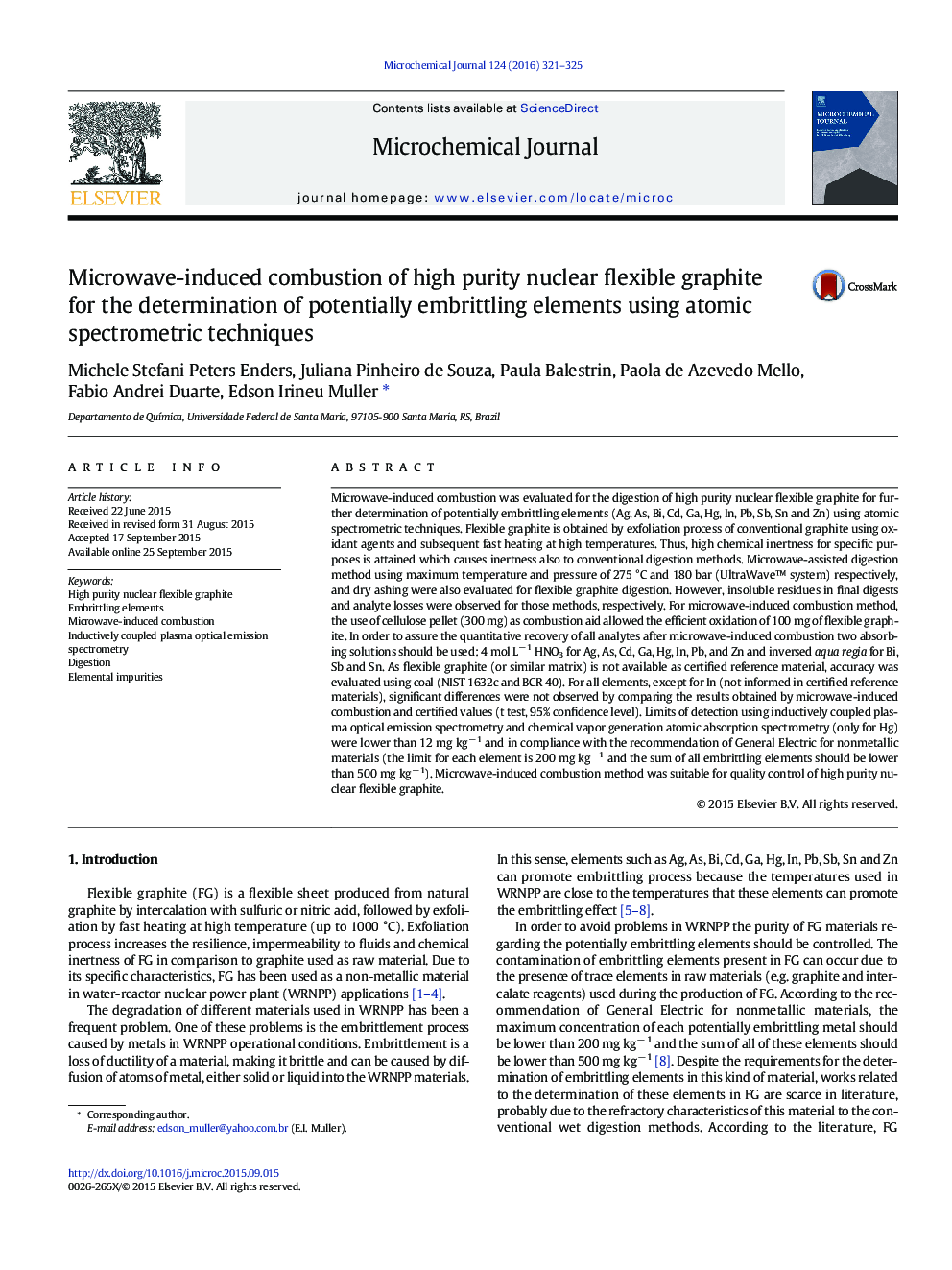| کد مقاله | کد نشریه | سال انتشار | مقاله انگلیسی | نسخه تمام متن |
|---|---|---|---|---|
| 7642194 | 1494870 | 2016 | 5 صفحه PDF | دانلود رایگان |
عنوان انگلیسی مقاله ISI
Microwave-induced combustion of high purity nuclear flexible graphite for the determination of potentially embrittling elements using atomic spectrometric techniques
ترجمه فارسی عنوان
احتراق حاصل از مایکروویو از گرافیت قابل انعطاف هسته ای با خلوص بالا برای تعیین عناصر بالقوه خرد شدن با استفاده از تکنیک های طیف سنج اتمی
دانلود مقاله + سفارش ترجمه
دانلود مقاله ISI انگلیسی
رایگان برای ایرانیان
کلمات کلیدی
خلوص بالا گرافیت قابل انعطاف هسته، عناصر خفیف، احتراق ناشی از مایکروویو، طیف سنجی نوری نوری پلاسما به صورت القایی، هضم، ناخالصی های عنصری،
موضوعات مرتبط
مهندسی و علوم پایه
شیمی
شیمی آنالیزی یا شیمی تجزیه
چکیده انگلیسی
Microwave-induced combustion was evaluated for the digestion of high purity nuclear flexible graphite for further determination of potentially embrittling elements (Ag, As, Bi, Cd, Ga, Hg, In, Pb, Sb, Sn and Zn) using atomic spectrometric techniques. Flexible graphite is obtained by exfoliation process of conventional graphite using oxidant agents and subsequent fast heating at high temperatures. Thus, high chemical inertness for specific purposes is attained which causes inertness also to conventional digestion methods. Microwave-assisted digestion method using maximum temperature and pressure of 275 °C and 180 bar (UltraWave⢠system) respectively, and dry ashing were also evaluated for flexible graphite digestion. However, insoluble residues in final digests and analyte losses were observed for those methods, respectively. For microwave-induced combustion method, the use of cellulose pellet (300 mg) as combustion aid allowed the efficient oxidation of 100 mg of flexible graphite. In order to assure the quantitative recovery of all analytes after microwave-induced combustion two absorbing solutions should be used: 4 mol Lâ 1 HNO3 for Ag, As, Cd, Ga, Hg, In, Pb, and Zn and inversed aqua regia for Bi, Sb and Sn. As flexible graphite (or similar matrix) is not available as certified reference material, accuracy was evaluated using coal (NIST 1632c and BCR 40). For all elements, except for In (not informed in certified reference materials), significant differences were not observed by comparing the results obtained by microwave-induced combustion and certified values (t test, 95% confidence level). Limits of detection using inductively coupled plasma optical emission spectrometry and chemical vapor generation atomic absorption spectrometry (only for Hg) were lower than 12 mg kgâ 1 and in compliance with the recommendation of General Electric for nonmetallic materials (the limit for each element is 200 mg kgâ 1 and the sum of all embrittling elements should be lower than 500 mg kgâ 1). Microwave-induced combustion method was suitable for quality control of high purity nuclear flexible graphite.
ناشر
Database: Elsevier - ScienceDirect (ساینس دایرکت)
Journal: Microchemical Journal - Volume 124, January 2016, Pages 321-325
Journal: Microchemical Journal - Volume 124, January 2016, Pages 321-325
نویسندگان
Michele Stefani Peters Enders, Juliana Pinheiro de Souza, Paula Balestrin, Paola de Azevedo Mello, Fabio Andrei Duarte, Edson Irineu Muller,
